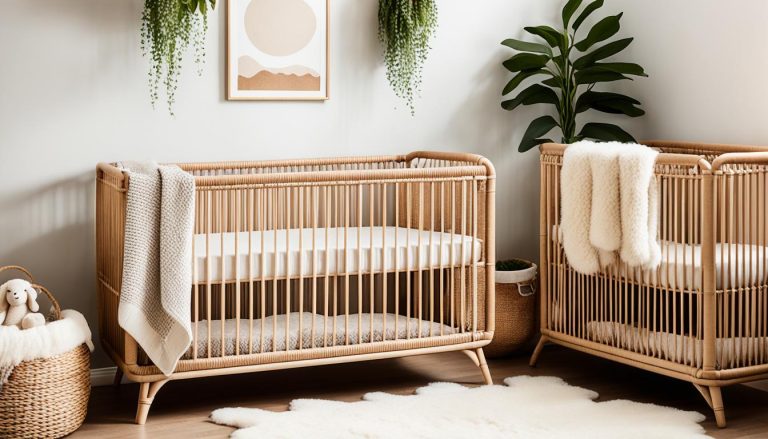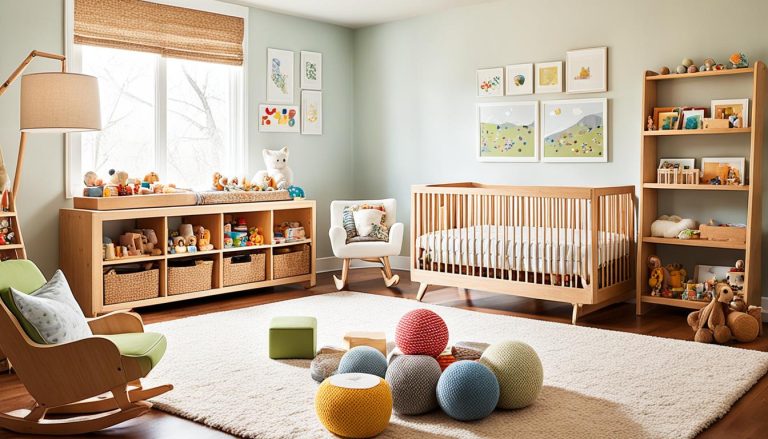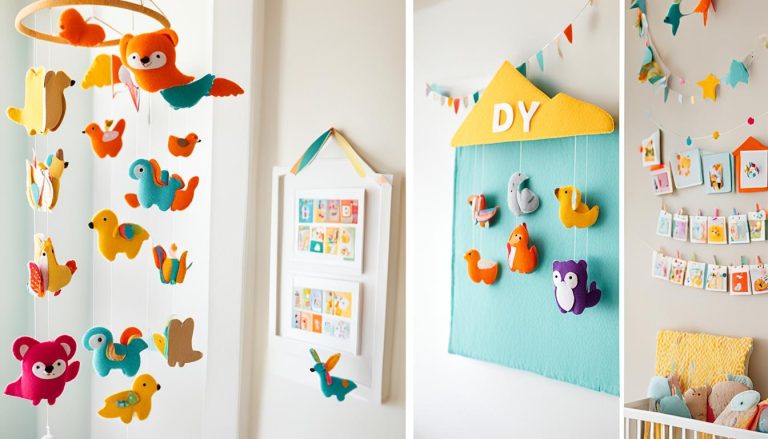Nursery That Grows with Your Child: Smart Design
houseremodelingnews.com may earn a commission if you purchase a product through one of our links
Did you know 94% of parents wish they had designed their nursery with more long-term adaptability in mind? This fact shows how crucial it is to make a nursery that changes as your child grows. As you start designing your nursery, think about how it can change from infancy to the toddler years and beyond.
When planning your nursery, focus on furniture that can change and designs that last. For example, the Cabina Crib by Casa Kids is made from 100% Baltic birch plywood. It’s strong and can turn into a toddler bed as your child gets bigger. This smart design saves money and adapts to your child’s needs.
Smart storage is vital for an adaptable nursery. Consider getting quality, long-lasting storage like Casa Kids’ Luna cabinet for toys. These items can change as your child’s needs do, making them key for a nursery that grows with your child.
A well-designed nursery is about looks, function, and safety. When planning your baby’s room, remember the American Academy of Pediatrics suggests infants sleep near their parents for at least six months. This tip helps you make a space that suits you and your baby now and later.
Understanding the Concept of a Growing Nursery
Creating an adaptable nursery is a smart move for your baby’s space. It means planning for the future while meeting your newborn’s needs right now. Let’s see why this idea is important and how you can make it happen.
Why adaptable nursery design matters
An adaptable nursery design is key for your child’s changing needs. It saves time and money later on. You won’t have to redo the whole room every few years. Instead, you can make small changes as your child grows.
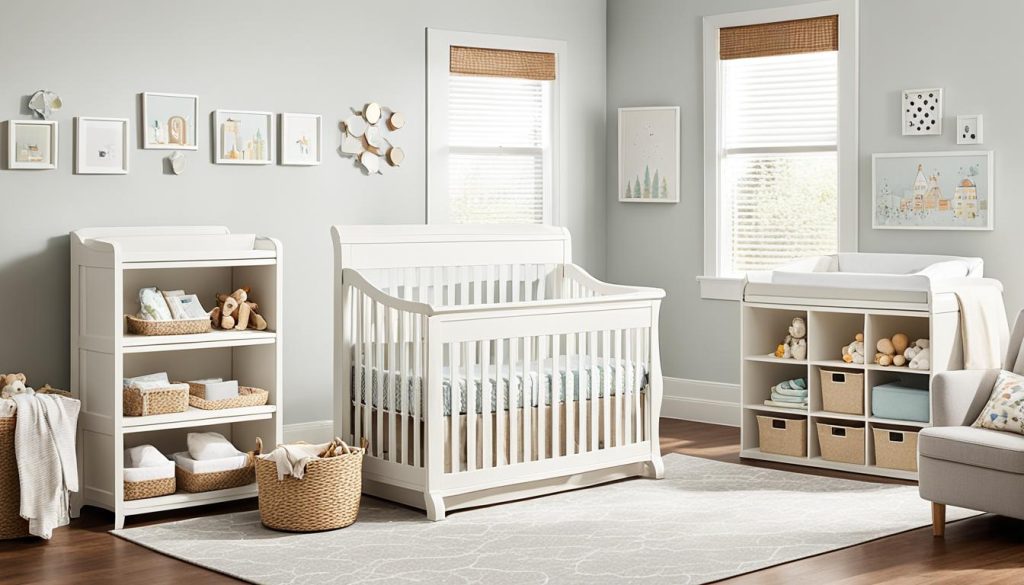
Long-term benefits of smart nursery planning
Smart nursery planning has many benefits. It lowers stress during changes and makes a space that grows with your child. Did you know parents in the 1980s used durable furniture that could be passed down to their grandkids? That’s the strength of careful planning!
Balancing current needs with future adaptability
Matching your baby’s current needs with future needs makes the space useful and nice-looking as your child grows. Think about these important points:
- Versatile nursery furniture that can be repurposed
- Timeless color schemes for nursery decor
- Flexible layouts that adapt to changing needs
Your nursery should have three main areas: sleeping, feeding, and diaper changing. As you plan, consider how these spaces can change into play areas, reading spots, or study corners. With smart planning, your nursery will grow with your child, offering the perfect setting for all their adventures.
Essential Elements of a Versatile Nursery
Creating a nursery that grows with your child needs careful planning and smart design. Let’s look at key elements that make a nursery both useful and adaptable.
Convertible Furniture Options
Choose convertible furniture to make the most of your money and space. A crib that turns into a toddler bed is a top pick, with 85% of parents saying it’s a must-have. Full dressers with removable changing trays give you more storage and flexibility than standalone tables.
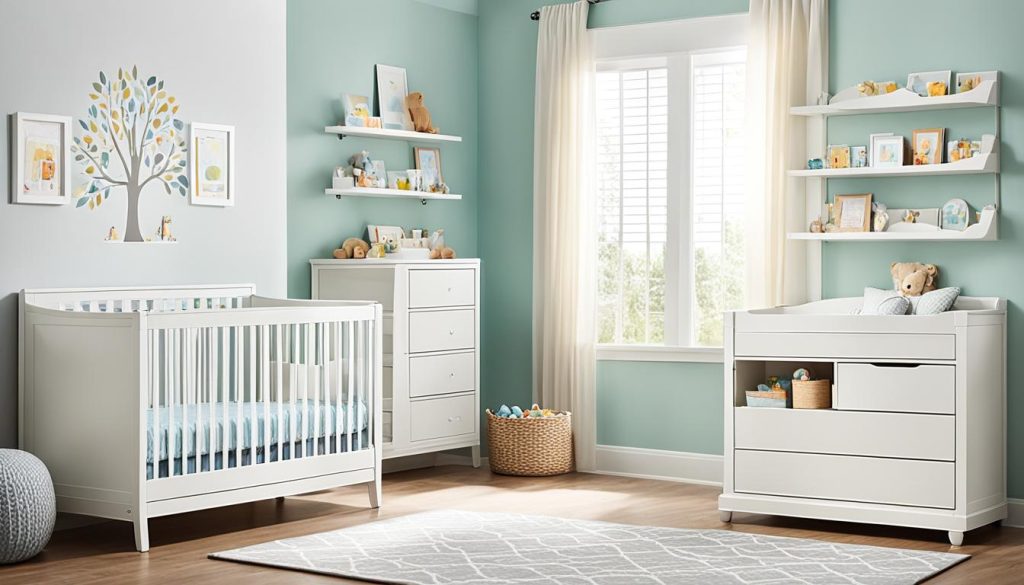
Multi-functional Spaces
Think about designing your nursery with different areas for sleeping, changing, playing, and learning. Use baskets for storing toys and keeping things organized – 90% of parents think they’re crucial. A comfy glider or rocking chair is great for feeding and bonding, with 75% of moms liking tall ones for better support.
Timeless Design Choices
Go for designs that will last from infancy to childhood. Neutral colors are popular with 70% of parents for their flexibility. Instead of themed nurseries, mix decor for a stylish look. Removable wallpaper lets you easily change things up as your child grows.
“A well-designed nursery combines functionality with style, creating a space that adapts to your child’s changing needs.”
Remember, keeping your nursery organized is important for its versatility. Use vertical storage and furniture with multiple uses to make the most of small spaces. With these tips, you’ll have a nursery that adapts to your child, offering comfort and functionality for years.
Choosing the Right Crib for Long-Term Use
Finding the perfect crib is key in designing your baby’s room. A convertible crib is a wise choice for your nursery furniture. It changes from a crib to a toddler bed and even a full-sized bed as your child grows.
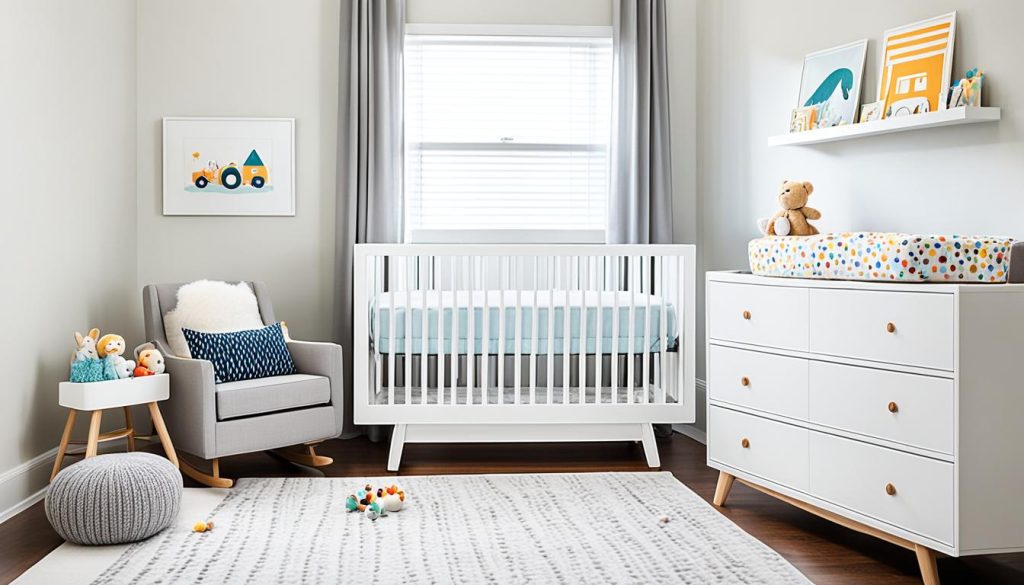
- Sturdy construction for long-lasting use
- Adjustable mattress heights for safety at different stages
- Non-toxic finishes to protect your baby’s health
- Style that complements future room designs
Many trusted brands offer quality convertible cribs. Delta Children and Graco have been around for decades and sell their cribs at big stores. For luxury, Pottery Barn Kids and Nestig have high-end convertible cribs with stylish designs.
“A well-chosen convertible crib can serve your child from infancy through young adulthood, making it a worthwhile investment in your nursery furniture.”
In the U.S., cribs must meet safety rules set by the Consumer Product Safety Commission. Look for certifications from the Juvenile Products Manufacturers Association for extra peace of mind. Choosing a quality convertible crib means getting a key piece of furniture that grows with your child and fits your changing nursery.
Creating a Nursery That Grows with Your Child
Designing a nursery that grows with your child is a smart move. It saves money and makes sure the room changes as your child does. Let’s look at some tips to make a room that lasts.
Incorporating Adaptable Elements
Choose furniture that changes as your child grows. The Cloud Crib by Nestig turns from a newborn crib to a toddler bed. It’s a piece that lasts for years. The Criss Cross Side Table also offers a classic look that fits any stage of life.
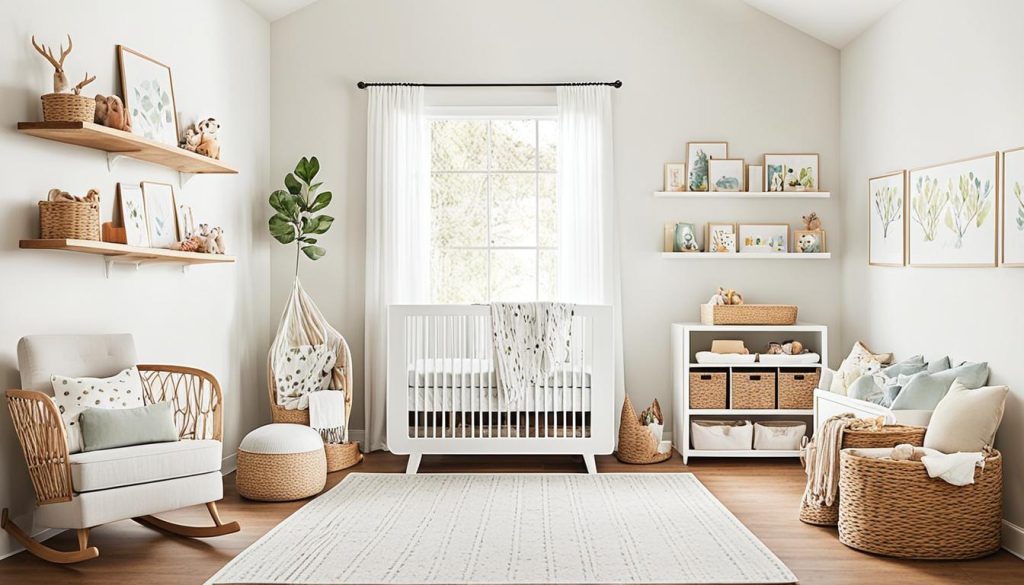
Planning for Different Age Stages
Plan your nursery for the future. Pick a crib mattress that works for infants and toddlers. The Sunrise Rug by Nestig comes in many colors and designs. It makes a space that grows with your child.
Design Strategies for Longevity
Use colors like white, gray, or dark brown for a timeless look. Themes like nature, nautical, or geometric shapes are great choices. They change as your child grows. Use artwork from other rooms for a personal touch without spending a lot.
“Design a nursery that evolves with your child, from infancy through the preschool years and beyond.”
Creating a flexible space means mixing quality and affordable items. This way, you can easily update the room without spending a lot.
Color Schemes and Themes That Stand the Test of Time
Creating a timeless nursery design means picking colors and themes that grow with your child. Gender-neutral themes are now more popular, with a 25% increase over traditional ones. Let’s look at some ideas for a versatile and lasting space for your little one.
Gender-neutral Palette Ideas
Go for soft, muted colors in your nursery. Pastel yellows and pinks are top choices for their calming effect, picked by 60% of experts. Nature-inspired colors, used in 45% of nurseries, bring a peaceful feel that everyone loves.
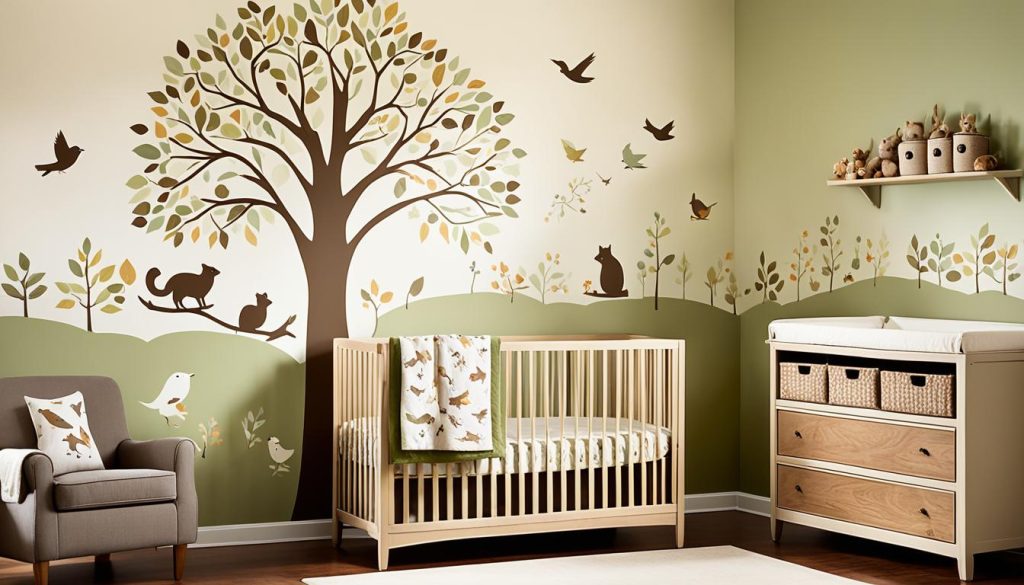
Themes That Transition Well
Pick themes that can change as your child grows. Forest animals, outer space, and vintage-inspired are great choices. For a nursery that lasts, think about adding things like:
- Teddy bears
- Hot-air balloons
- Woodland creatures
- Ocean motifs
Incorporating Accent Colors for Easy Updates
Use wall decals for easy theme changes. 70% of nurneys have these versatile decorations. Add accent colors with bedding, curtains, and artwork that’s easy to switch out. This way, you can update the room as your child’s tastes change without redoing everything.
“A well-designed nursery grows with your child, adapting to their changing needs and interests.”
The secret to a great nursery is mixing current trends with timeless pieces. By picking versatile colors and themes, you’ll make a space that stays relevant and dear for years.
Smart Storage Solutions for Evolving Needs
Creating a nursery that grows with your child means using smart storage solutions. As your little one gets older, their needs change. So, your storage setup should change too. Let’s look at some nursery organization hacks that make room transition easier.
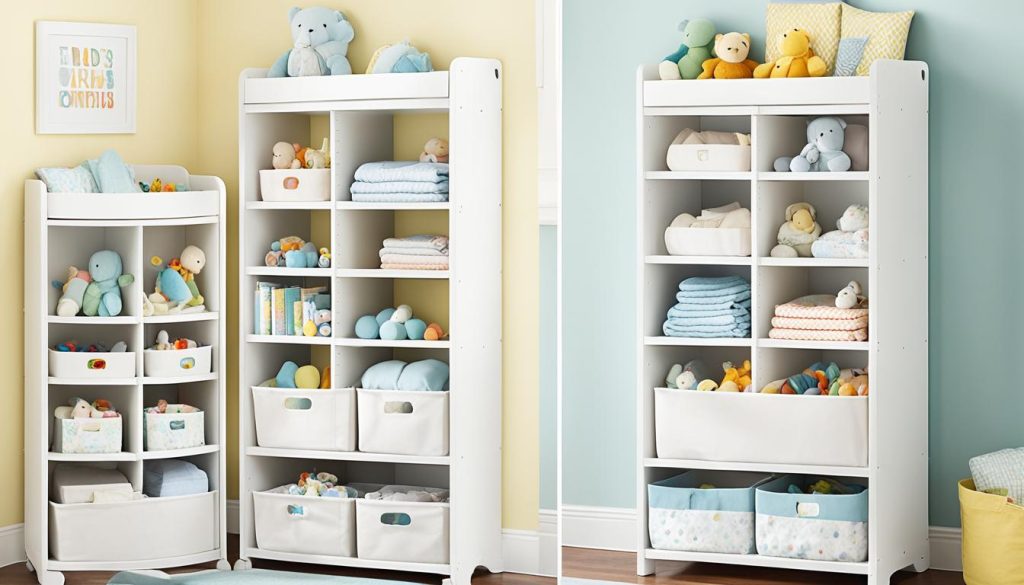
Start with modular cube organizers. These units change easily as your child grows. Put them low for toys now, and raise them later for books or school stuff. Under-bed storage is great for saving space. Use rolling bins for extra bedding or out-of-season clothes.
Think about multi-functional furniture pieces. An ottoman with hidden storage can keep blankets and be a place to sit. A dresser with a removable changing tray works as a diaper station now and for clothes later.
- Use labeled bins for easy organization
- Install floating shelves for decor and storage
- Repurpose a bookshelf into a homework station
- Utilize closet systems with adjustable components
Wall space is often wasted. Mount pegboards or magnetic strips for small items. As your child grows, these can show off artwork or hold school stuff. Remember, the key to great nursery organization is being flexible. Pick storage solutions that can change and grow with your little one.
Furniture Placement for Maximum Flexibility
Creating a smart nursery layout and furniture arrangement is crucial. It makes a nursery that grows with your child. A well-planned space changes as your child does, keeping it functional and stylish.
Creating Zones Within the Nursery
Divide your nursery into areas for sleeping, changing, feeding, and playing. This makes the space efficient. Put the crib away from windows for safety. Add a cozy feeding corner with a comfortable chair.
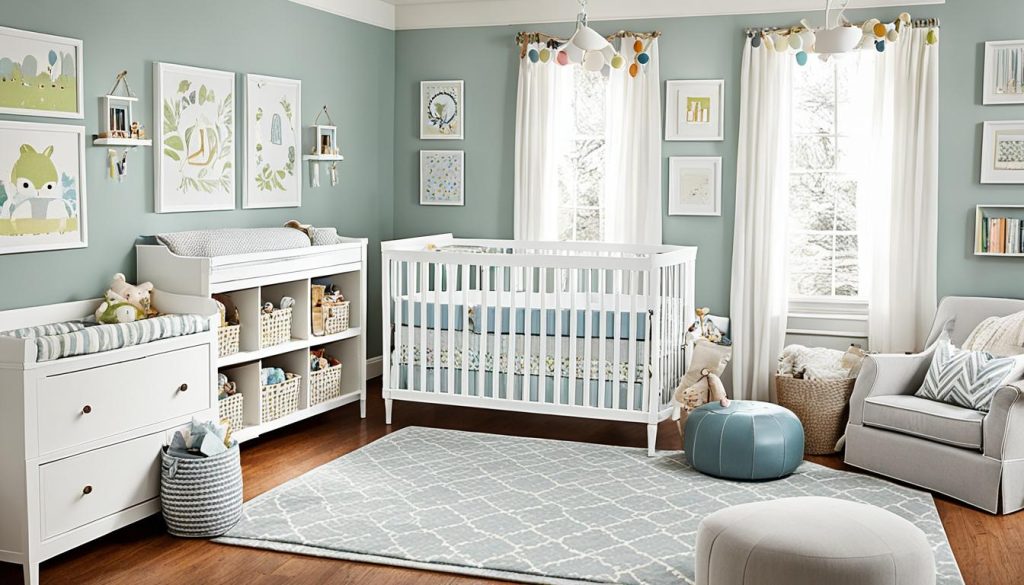
Room for Growth and Play
Leave enough floor space for your child to move around as they grow. This area is key for crawling, walking, and playing. Consider a soft rug to define the play zone and make tummy time comfy.
Adapting Furniture Arrangement
Choose furniture that’s easy to move or convert. A convertible crib saves space and money. Use furniture like a dresser with a changing topper for extra storage.
- Use vertical storage solutions to maximize space
- Incorporate modular shelving units for flexibility
- Choose furniture with built-in storage options
A well-planned nursery layout with smart furniture arrangement makes parenting easier. It adapts to your child’s needs, making life more enjoyable.
Incorporating Educational Elements in Nursery Design

Creating an educational nursery design is a smart way to support your child’s development from day one. By adding learning elements to your nursery decor, you make a space that grows with your child. This approach helps in fostering a stimulating environment.
Begin with a cozy reading nook. Place a small bookshelf with books for your child’s age and a comfy chair. This spot will change as your child grows. It encourages a love for reading and learning.
Think about these educational additions for your nursery:
- Interactive wall decals featuring letters, numbers, or shapes
- A child-safe wall-mounted chalkboard or whiteboard for creative expression
- Colorful posters showcasing the alphabet, numbers, or animals
- Toys that stimulate cognitive skills at different developmental stages
Using colors like blue and yellow can help babies see shapes and improve spatial awareness. Add different textures to engage your child’s senses. With these elements, your nursery becomes a fun, educational place that changes as your child grows.
“A well-designed nursery isn’t just about aesthetics; it’s about creating a space that nurtures learning and growth.”
With these ideas, you’re setting the stage for your child’s development journey. As your child grows, you can update and adapt the space to fit their changing interests and learning needs.
Lighting Considerations for Different Stages
Creating the perfect nursery lighting is key for your baby’s comfort and growth. A smart lighting plan changes with your child as they grow.
Layered Lighting for Various Activities
Use a layered lighting approach in the nursery. Ambient lighting provides overall light, task lighting for diaper changes and feeding, and accent lighting for a cozy feel. Bright light helps with learning during the day. Dim light is great for bedtime routines.

Adjustable Lighting Options
Choose lighting that grows with your child. Dimmable overhead lights let you adjust the brightness for different tasks. Wall sconces or clip-on lights can be moved as your child’s needs change. LED night lights are energy-efficient and provide a soft glow for late-night checks.
Safety Considerations for Different Age Groups
Put safety first when picking nursery lighting. Go for UL-listed or ETL-certified options to avoid electrical hazards. As your child moves around, make sure all cords and fixtures are safely out of reach. Motion sensor lights are handy and safe for nighttime care.
- Opt for warm lighting (2700K-3000K) in sleeping areas
- Use cooler light (4000K-5000K) for daytime activities
- Consider personalized name sign nightlights for a special touch
By planning your nursery lighting well, you make a space that supports your child’s growth from infancy to beyond.
Flooring Options That Grow with Your Child
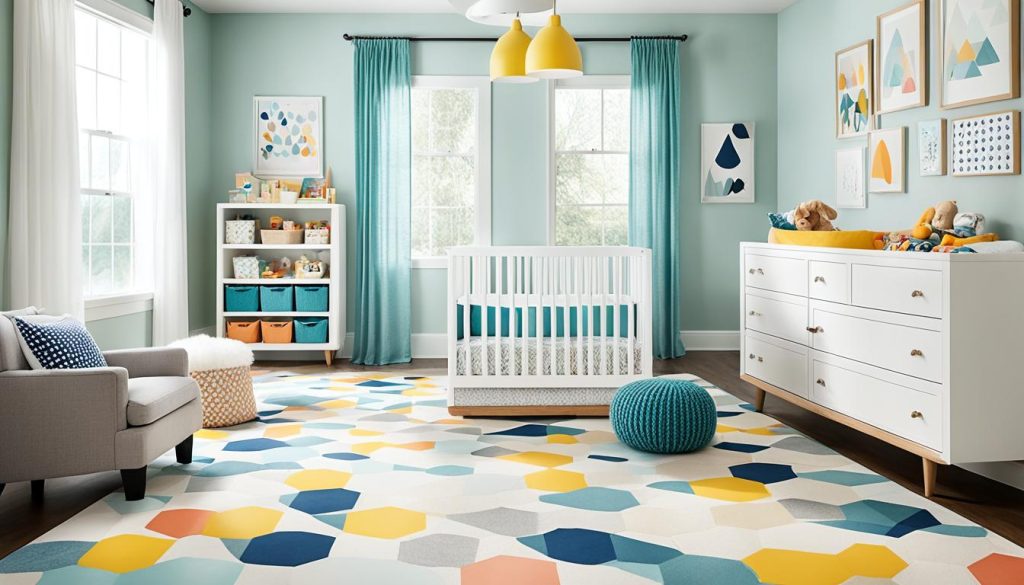
Choosing the right nursery flooring is key for a safe and comfy space that changes as your child grows. It should be easy to clean, tough, and soft for crawling babies and running toddlers. Let’s look at some options that can change with your child’s needs.
Hardwood floors are a top pick for nurseries. They’re simple to clean and can last for many years, growing with your child. Even though they cost more at first, hardwood also adds value to your home. For a more affordable choice, think about luxury vinyl plank (LVP) flooring. It looks like wood but is better at resisting water and softer to walk on.
Carpet is also a favorite for nurseries. It gives a soft surface for babies and helps keep the room quiet. Choose low-pile carpets that are easier to clean. As your child gets older, you can easily switch up the room’s look with new area rugs.
- Hardwood: Durable and easy to clean
- Luxury Vinyl Plank: Affordable and water-resistant
- Carpet: Soft and noise-reducing
- Area Rugs: Versatile for room transitions
For play areas, think about interlocking foam tiles. They’re soft, safe, and can be taken out as your child grows. This makes it easy to change the room as your little one’s needs change.
“The best nursery flooring grows with your child, balancing comfort, safety, and style.”
The best nursery flooring should handle spills, scratches, and the wear and tear of raising a child. By picking wisely, you’ll make a foundation that supports your child’s growth for years.
Wall Decor and Art That Evolves
Nursery wall decor is key to a stimulating and adaptable space for your child. As your child grows, their interests change. Let’s look at ways to keep their room fresh and engaging.
Removable Wall Decals and Murals
Removable wall decals are great for changing art displays. Bright yellow and white daisy decals bring joy to nurseries. They’re easy to put up and take down, letting you change your child’s room’s look easily.
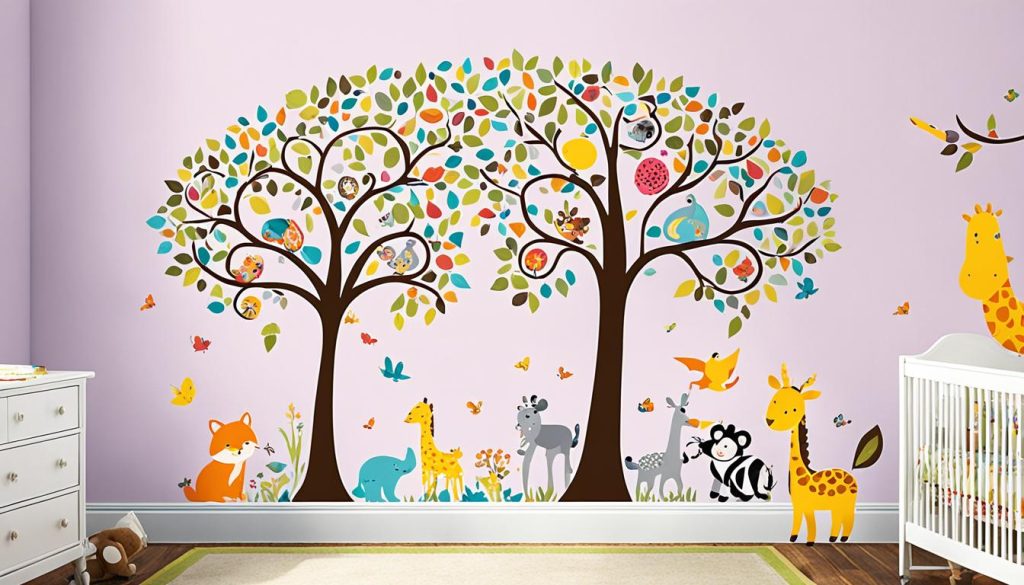
Gallery Walls for Easy Updates
Build a gallery wall with frames that can be swapped out. This lets you show off your child’s art or change pictures as they grow. Affordable art starts at $12 on Society6. For something unique, Etsy has custom prints from $6 to $42+.
Incorporating Your Child’s Artwork
Show your child’s art to make them feel proud. Use magnetic paint or cork board for easy, changeable displays. This personalizes the space and boosts your child’s confidence. Change the artwork often to keep the room fresh and celebrate their creativity.
The secret to great nursery wall decor is being flexible. With these evolving art displays, you’ll have a space that grows with your child. It will reflect their changing tastes and interests over time.
Technology Integration in a Growing Nursery
Creating a smart nursery that grows with your child means adding tech wisely. A tech-friendly room makes your child more comfortable and helps with learning and growth. Let’s see how to add gadgets that grow with your child.
Smart lighting is a smart choice. You can change the brightness and color for different times, like feeding or playing. As your child gets older, you can set lights for bedtime or studying.
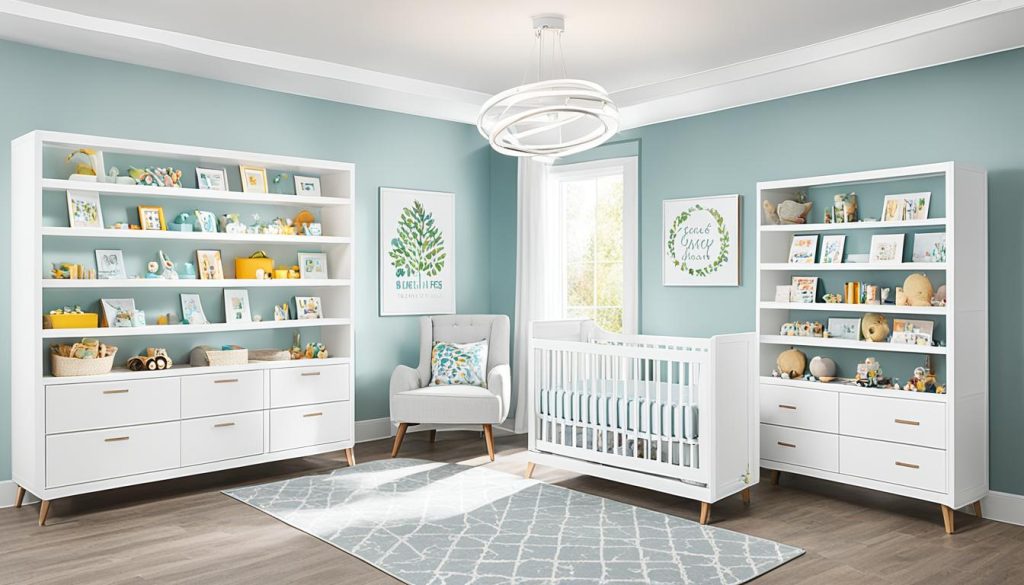
Sound machines are also great for a smart nursery. They can play soft noise for babies and calming music for older kids. Choose devices with playlists you can change to fit your child’s tastes.
It’s important to plan for the future in a nursery. Put in charging stations and think about where outlets go. This way, you’ll have space for all the devices your child will use as they grow.
“75% of parents believe that technology is an essential tool for their child’s learning and development in a nursery setting.”
Multi-use gadgets are very useful in a tech-friendly room. For example, projection systems can be nightlights for babies and educational displays for older kids. These gadgets can change as your child does, meeting their new needs.
- Smart baby monitors that convert to room monitors
- Interactive learning tablets with age-appropriate content
- Adjustable sound systems for stories and music
While technology is great, don’t forget to keep things balanced. Mix tech with traditional items for a nursery that supports your child’s growth and learning.
Safety Features That Adapt to Different Ages
Keeping your nursery safe is a top priority for parents. As your child grows, so should your safety steps. Let’s look at some key ways to keep your little one safe at every stage.
Childproofing Essentials for Each Stage
Infants and toddlers don’t control their actions well. It’s important to be ahead in childproofing. Start with things like outlet covers, furniture anchors, and cord systems. Always check the nursery for safety before your child goes in.
- Install safety gates at stairways and doorways
- Secure heavy furniture to walls
- Cover sharp edges with corner guards
- Keep small objects out of reach to prevent choking hazards
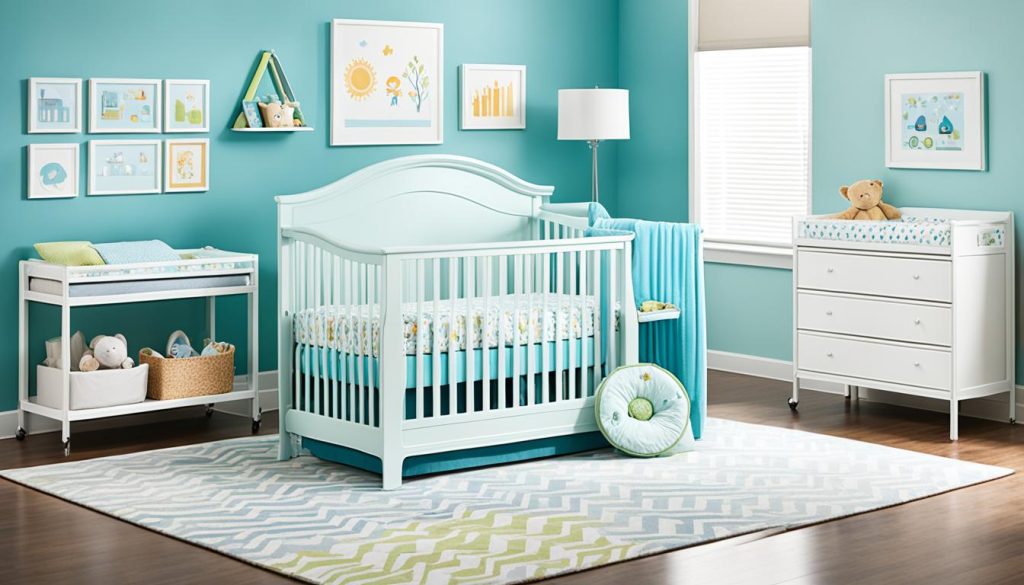
Adjustable Safety Measures
As your child gets older, your safety steps should too. Use safety gates and cabinet locks that can change or be removed when needed. Always check the nursery for any broken items and toys with missing parts.
Teaching Safety as Your Child Grows
Start teaching your child about safety as they get older. Show them what dangers are and how to stay safe. This teaching helps your child learn to be responsible and aware.
“Safety is not just about childproofing your home, it’s about child-proofing your child through education and guidance.”
Keep up with product recalls by visiting the Consumer Product Safety Commission website often. By using these safety tips, you’ll make a safe space that changes with your child’s needs.
Closing Thoughts
Creating an adaptable nursery is a journey that grows with your child. By following smart nursery design tips, you can make a space that changes as your child grows. Choose versatile pieces that offer long-term value.
For example, the Delta Children Emery 4-in-1 Convertible Crib costs about $200. It changes as your little one grows.
When planning your nursery, think about multi-functional items. The Storkcraft Avalon 6 Drawer Universal Dresser, around $300, is great for storage and as a changing station. The Babyletto Kiwi Electronic Recliner and Swivel Glider, priced at $700, is perfect for feeding and bonding.
Safety is key in your nursery. Invest in items like the Regalo Easy Step Extra Tall Walk-Thru Gate ($45) and Guardian Angel Window Guard ($100) to keep your child safe. Choose non-toxic options, like GREENGUARD Gold certified furniture and organic bedding, for a healthy environment.
The best nursery adapts to your family’s needs. Focus on flexible design and quality pieces. With these tips, you’re ready to start this exciting chapter of parenthood.



